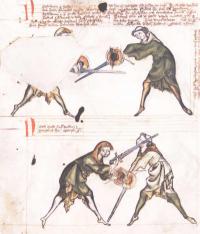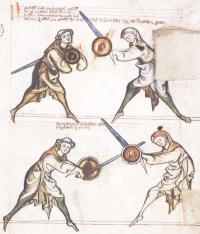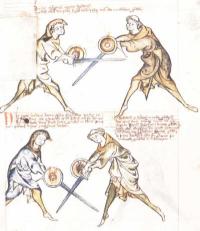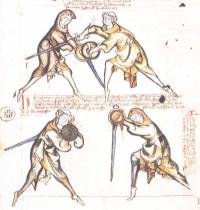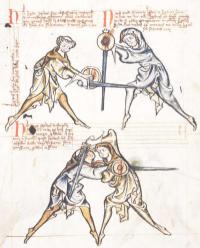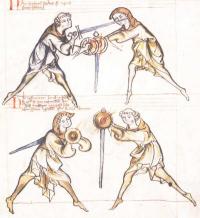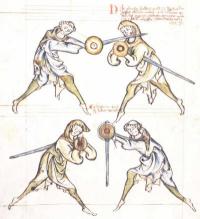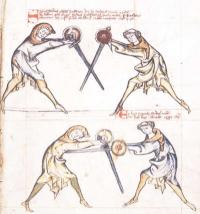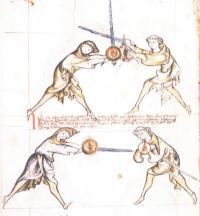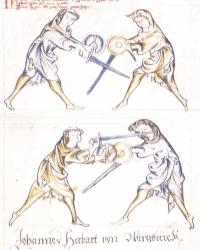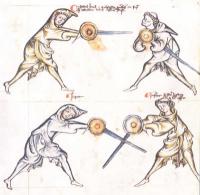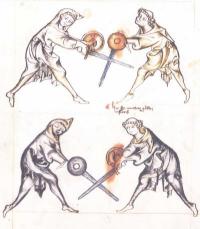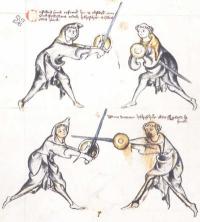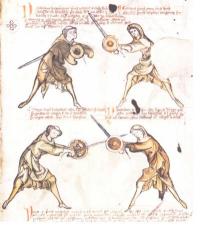
|
(+)N otandum hic continetur prima custodia, videlicet sub [brachio] obsesseo vero halbschilt ¶ Et consulo sano consilio quod il[...] sub brachio non ducat aliquam plagam quod probat de al[b]ersleiben, per raciones quia partem superiorem attingere non potest si inferiorem capiti erit perniciosum sed obsessor intrando potest eum invadere quandocumque si obmittit quod tenetur vt infra scriptum est
Versus:
Custodia prima retinet contraria bina
Contrarium primum halpschil langortque secundum
Dum ducitur halpschilt cade sub gladium quoque scutum
Si generalis erit recipit caput sit tibi stichschlach
Si religat calcat contraria si(n)t tibi schiltschlac
N otandum quod qui iacet superius dirigit plagam post [c]apud sine schiltslach si est generalis Si autem uis edoceri consilio sacerdotis tunc religa et calca
Nota quod prima custodia videlicet sub brachium potest obsederi se ipsa ita videlicet quod obsidens cum eadem custodia potest regentem primam custodiam obsidere nichilominus tamen regens custodiam primam econtrario possessorem obsidere potest obsessione quadam que quodammodo concordat cum possessione que vocatur halpshilt differt tamen in eo quod gladius sub brachio* extenditur supra scutum taliter quod manus regens scutum includitur in manu regente gladium |
(+)It is to be seen that here is the first ward contained, i.e. the one under the arm, and the displacer is in halpschilt. I give the good counsel that the one (assuming the ward) under the arm do not execute a strike, which is commendable from the albersleiben, for the reason that he could not reach the upper part, and (reaching anywhere) lower would be pernicious to the head. But the displacer entering to attack may reach him at any time if he fails to observe what is written below:
Verse: The first ward has two counters,
the first counter being halbschilt, the second Langort.
If Halbschild is executed, fall below both sword and shield.
If he is a common fencer, he will strike to the head, then you should apply stichschlach,
if he binds and enters, then you should counter with schiltschlac.
It is to be seen that the one who is higher is directing a strike to the head, without schiltslac, if he is a common fencer. But if you would be instructed by the priest's counsel, do bind and enter.
Note that the first ward, i.e. the one under the arm, may be displaced by itself, namely, the displacer may displace the one assuming the first ward with that selfsame ward. Nevertheless, the one assuming first ward can displace the displacer with a displacement that in a way corresponds to the displacement called halpschilt, but differs from it in this, that the sword below the arm is extended above the shield, so that the hand holding the shield is enclosed by the hand holding the sword. |
 Notes on this presentation
Notes on this presentation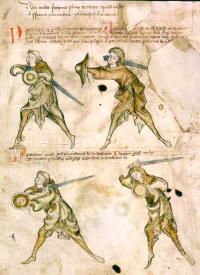
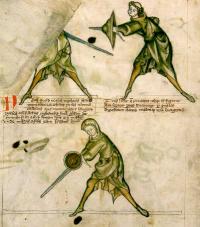
 lutegerus: presumably tha name of the author / sacerdos: Liutger. C. f.
lutegerus: presumably tha name of the author / sacerdos: Liutger. C. f. 
